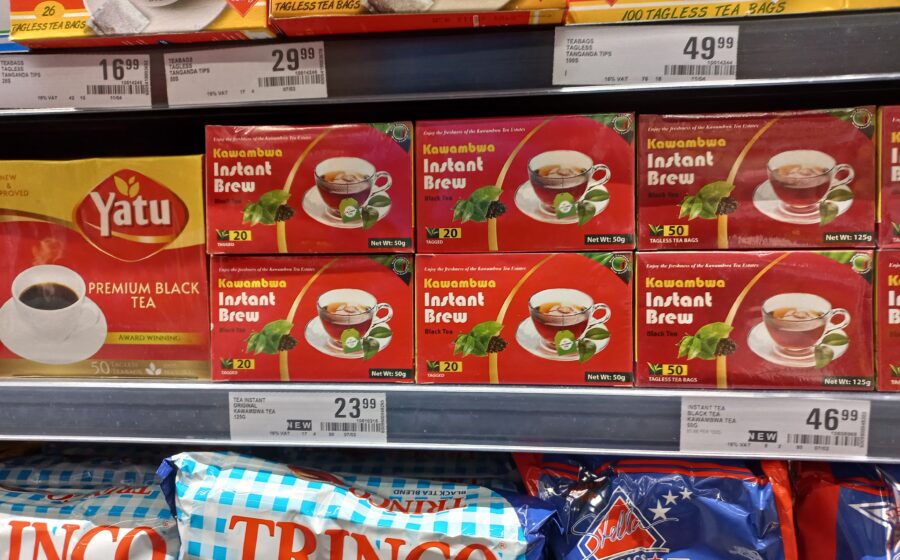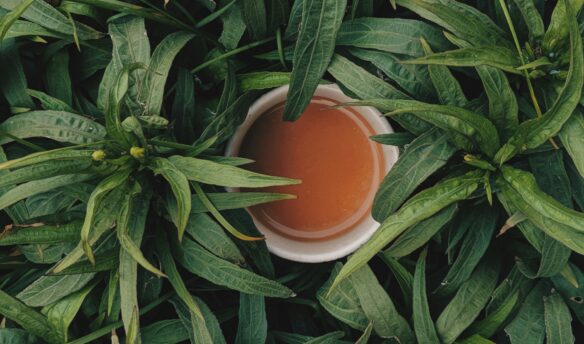In 1991, after 27 years of operating as a one-party state, Zambia held its first multi-party election and elected Frederick Chiluba as its president. Chiluba outed Kenneth Kaunda, Zambia’s first president who had outlawed all political parties except his own (he was a member of the United National Independence Party), and Chiluba’s administration introduced mass privatization of state-owned enterprises.
From 1992 into the early 2000s, industries that had been publicly operated—from bakeries to mines—became privatized, including Kawambwa Tea Industries Limited, one of Zambia’s largest and most influential tea plants.
Kawambwa Tea was last owned by Khumul Holdings, a Zimbabwean firm that held onto the tea company until 2016 when the government reclaimed ownership of the then-struggling tea company. The brand was floundering: Kawambwa Tea was in desperate need of money, the plant was barely processing tea, and the once-iconic brand was just a memory for most Zambian residents, barely gracing Zambian grocery shelves.
But switching back to government ownership helped dig Kawambwa Tea out of obscurity and resume its status as one of Zambia’s leading tea producers. Now, Kawambwa Tea processes 30 tons of tea per day and employs around 700 permanent staff, and grows five different tea varieties across 423 hectares of land. Kawambwa’s history is a story of turmoil and tumult through public and private ownership, but demonstrates the power of establishing infrastructure and how careful investment can help stabilize once-struggling industries.
A History of Survival
The ups and downs of Kawambwa Tea are visible in how consumers have viewed the brand over the last few decades. “I had to train myself to buy Kawambwa Tea,” says Lisa Mweemba, a lifelong tea lover based in Lusaka, the capital of Zambia. “It’s not an inferior brand as some people think,” she says, reflecting a widespread sentiment of the brand as it has worked to rebuild its reputation and success.
However, Kawambwa’s recent push to improve quality and regain market share has not gone unnoticed by tea drinkers like Mweemba, who take pride in enjoying tea grown in Zambia. “I usually [drink] Five Roses—a South African brand of black tea—but I realized that I needed to support local brands for us to grow as a country. I still buy other teas, but I make sure to purchase Kawambwa Tea every month.”
Privatization seemed like the answer to the problems that plagued Kawambwa Tea initially, but its current success shows that government investment and care are what the company needed to thrive.
To appreciate the current success of Kawambwa Tea, we have to start at the beginning: Kawambwa Tea Industries was started in 1969 in the Kawambwa district of Northern Zambia as a government tea-growing project. The initial vision was to provide the newly independent Zambia with locally-grown tea and to ensure the residents of the Kawambwa district had a profitable and sustainable source of revenue. “The government-established tea company was set up for purposes of promoting self-reliance through import substitution, enhancing food security, creating employment opportunities for the surrounding communities, supporting poverty reduction initiatives, and accelerating social infrastructure development,” Kawambwa Tea’s website states.
However, the company struggled. The plant was poorly run: record keeping was non-existent, and the accounts department was nearly as scant. The government then worked to commercialize the plant in 1975, which helped to stimulate the economy of Kawambwa town and aided the industrialization of the entire district. A year later, in 1976, the first tea processing factory was commissioned, the first-ever for Zambia.
Kawambwa Tea experienced an economic downturn in the late 80s due to countrywide protests that put pressure on the one-party state system in Zambia, and the country held its first multi-party election. Like most state-owned companies, the tea plant was privatized by the new government in 1991, but privatization brought even more turmoil and instability, and ownership of Kawambwa Tea changed hands often. Eventually, in 2016, then-president Edgar Lungu announced that the government signed an acquisition order to repossess the plant, taking control away from Khumul Holdings and ending a nearly twenty-year run of private ownership that nearly sank the tea company.
Upon acquisition, the government handed over the management of the plantation to the Zambia Forest and Forestry Industries Corporation (ZAFFICO), Zambia’s largest forestry company, and its commercialization to the Industrial Development Corporation (IDC), a state-owned enterprise mandated to develop Zambia’s domestic industries. Bringing in ZAFFICO and the IDC was a strategic move to change the tide. Under private ownership, Kawambwa Tea nearly went extinct, but these two governmental groups were determined to revitalize the brand and start producing and selling more tea for the Zambian market and beyond.
A Learning Curve
First, the government had to increase production—tea production dropped significantly during Kawambwa’s private ownership. In 2019, ZAFFICO staff and a team of government officials went to Kenya, Africa’s largest tea producer, to learn about their out-grower methods that successfully supplemented their tea industry. Kenya has approximately 700,000 out-grower farmers, or small-scale farmers (many own between one to ten hectares of land) that supply tea to large commercial brands and plants.
Following the visit, the government decided to implement its own out-grower model, and in 2022, Kawambwa Tea Out-Grower Association was formed. “The association was formed to cater to the growing needs of the farmers,” says Wiza Sindazi, the president of the out-grower group. “We currently have over 600 farmers registered with us who are growing tea to supply to the Kawambwa processing plant.” Producers can participate in Kawambwa’s out-grower program if they grow their tea within a 30-mile radius of the plant.
Switching back to government ownership helped dig Kawambwa Tea out of obscurity and resume its status as one of Zambia’s leading tea producers—now, Kawambwa Tea processes 30 tons of tea per day.
The government groups also decided to import 300,000 tea cuttings, which are now grown side by side with older tea bushes. According to Moses Silanda, general manager for Kawambwa Tea, the imported tea cuttings comprised ten species procured from the Tea Research Institute of Kenya, which helped Kawambwa diversify its crops and offer a wider variety of tea options for consumers.
Thriving Under Challenges
The main challenge for Kawambwa is helping smallholder farmers get started. “Tea is an expensive venture; it costs around $1700 to plant a hectare of tea. This is costly for people in rural communities around Kawambwa. So those who get started look at this as a long-term investment for their families,” Sindazi says.
Although the Zambian government provides support to farmers under the Farmer’s Input and Support Programme (FISP), an organization designed to support small to medium-scale farmers in the country through grants and equipment, this resource isn’t available to tea growers looking to be part of out-grower programs. Sindazi says this has hindered the growth of the farming industry around the Kawambwa region and, subsequently, Kawambwa Tea.
However, that hasn’t stopped the growth of Kawambwa Tea. Boxes of Kawambwa Tea can once again be found on all supermarket shelves in Zambia. Most stores carry Kawambwa’s black tea, but patrons can also find flavored varieties like ginger, garlic, lemon, cinnamon, and herbal eucalyptus. But Kawambwa still has to fight preconceived notions about its flavor and quality: supermarkets commonly place their teas on the bottom shelves as most citizens prefer foreign tea brands, especially black teas.
And Kawambwa is working on getting its teas into more spaces by introducing accessible formats beyond loose-leaf teas. “We introduced envelope teabags—a five-in-one box which contains our black, ginger, lemon, herbal, and garlic teas,” Silanda says. Right now, they supply many hotels and lodges in the northern region of Zambia and plan to expand the distribution of envelope teabags to all corners of the country.
Privatization seemed like the answer to the problems that plagued Kawambwa Tea initially, but its current success shows that government investment and care are what the company needed to thrive. In Zambia, the phrase “government-owned” had become synonymous with run down and defunct, but the success and growth of Kawambwa Tea have bucked that notion, and the brand continues to thrive.















